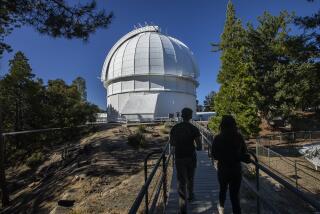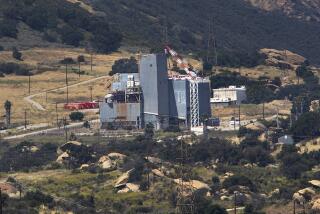University Taking Over Biosphere : Science: Columbia will run scientific, educational and growing tourist operations at the huge glassed-in environment.
- Share via
TUCSON — Columbia University is taking over management of Biosphere 2, the glassed-in environment criticized by scientists when eight people tried to live there in self-supporting isolation for two years.
The agreement being announced today gives Columbia five years to run the huge greenhouse in an attempt to bring scientific legitimacy to a project that began as a sort of New Age ecological ark.
Edward P. Bass, the Texas billionaire who bankrolled the project and then wrested control from the cult-like group that built it, will continue to provide the bulk of the funding.
Exact terms weren’t disclosed, but officials said Biosphere’s budget will be $15 million to $17 million a year.
Columbia’s Lamont-Doherty Earth Observatory will run scientific and educational operations as well as the growing tourist business, university President George Rupp said. But the university doesn’t plan any long live-in missions.
The three-acre complex in the desert 30 miles north of Tucson contains replicas of an ocean, savanna, rain forest and marsh, and a working farm, allowing scientists to study Earth’s processes under controlled conditions.
“The intellectual lure of the Biosphere is tremendous,” said Columbia geochemistry professor Wallace Broecker, a member of the National Academy of Science who has been involved with the project for several years.
On Sept. 26, 1991, four men and four women donned “Star Trek”-style uniforms and trooped through the giant terrarium’s air-lock doors, accompanied by music, visionary rhetoric and media hype.
Their professed goal: to spend two years of total self-sufficiency, growing their own food and recycling air, water and waste, as if they were on a long space mission.
Soon, however, a series of news leaks revealed that management was fudging on the self-sufficiency promise.
An air scrubbing system had to be installed because the natural systems couldn’t keep carbon dioxide in balance. Fresh outside air had to be pumped in. A crew member who left for treatment of a finger injury secretly took back two duffel bags of non-food supplies.
Crops failed and the crew members lost an average of 25 pounds by the time they emerged Sept. 26, 1993.
Questions arose about the scientific and business abilities of top managers Margret Augustine and John Allen, leaders of a core group that had been together since their days on a theater-oriented New Mexico commune in the 1970s.
Bass fired Augustine and Allen in March, 1994, prompting a sabotage attempt by two former crew members who sneaked up one night and threw open the outside doors of the sealed project.
Bass’ new managers formed a partnership with Columbia in August, 1994, to gather a consortium of scientists from such schools as Harvard, Stanford and Yale to write a long-term scientific plan for the $150-million-plus project.
Columbia will make Biosphere available to scientists to study such environmental issues as global climate change, biodiversity and sustainable agriculture, said Michael Crow, Columbia vice provost.
“It means Biosphere 2 is going to evolve into the major scientific and educational center it was always intended to be,” said Stephen Bannon, acting chief executive officer.






